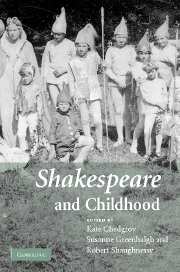Book contents
- Frontmatter
- Contents
- Acknowledgements
- Notes on contributors
- Note on the text
- 1 Introduction
- PART 1 SHAKESPEARE'S CHILDREN
- 2 Introduction: ‘What, are they children?’
- 3 Little princes: Shakespeare's royal children
- 4 Father-child identification, loss and gender in Shakespeare's plays
- 5 Character building: Shakespeare's children in context
- 6 Coriolanus and the little eyases: the boyhood of Shakespeare's hero
- 7 Procreation, child-loss and the gendering of the sonnet
- PART 2 CHILDREN'S SHAKESPEARES
- APPENDICES
- Index
3 - Little princes: Shakespeare's royal children
Published online by Cambridge University Press: 22 September 2009
- Frontmatter
- Contents
- Acknowledgements
- Notes on contributors
- Note on the text
- 1 Introduction
- PART 1 SHAKESPEARE'S CHILDREN
- 2 Introduction: ‘What, are they children?’
- 3 Little princes: Shakespeare's royal children
- 4 Father-child identification, loss and gender in Shakespeare's plays
- 5 Character building: Shakespeare's children in context
- 6 Coriolanus and the little eyases: the boyhood of Shakespeare's hero
- 7 Procreation, child-loss and the gendering of the sonnet
- PART 2 CHILDREN'S SHAKESPEARES
- APPENDICES
- Index
Summary
CHILDHOOD
Five children appear in Shakespeare's Richard III, including, unusually, a little girl. One boy appears briefly as a page. The primary role of the others is evidently to throw into relief the tyranny of Richard, as he remorselessly clears them out of his path to the throne. Even now, the princes he murders in the Tower of London remain a legendary instance of childhood helplessness in the face of adult cruelty. While all Richard's child victims are repeatedly identified, whatever their ages, as ‘babes’, the play credits them not only with the vulnerability they all share but also with varying degrees of autonomy. If, on the one hand, Clarence's orphans are presented as naïve in their ignorance of the world and incapable of intervention on their own behalf, the princes, on the other, are seen as more knowing and more independent. In its depiction of the encounter between the princes and Richard, this play of perhaps as early as 1591 begins ascribing to childhood a life of its own.
The representation of the princes themselves, however, is not without its attendant questions from a twenty-first-century perspective. In detail, the scene does not seem to charm the audience in quite the ways we might now expect. Can the early modern understanding of childhood illuminate the play's presentation of the princes? Can the princes in turn tell us something about the cultural history of childhood?
- Type
- Chapter
- Information
- Shakespeare and Childhood , pp. 32 - 48Publisher: Cambridge University PressPrint publication year: 2007
- 6
- Cited by



